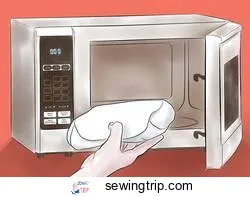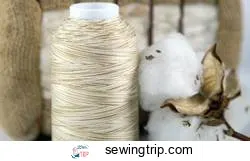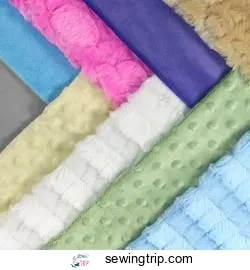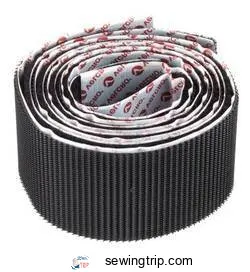This site is supported by our readers. We may earn a commission, at no cost to you, if you purchase through links.
As we obtain deeper right into the winter season, the concept of microwavable heating bags obtains ever before more appealing. Comfortable, warming, as well as practically as quick to make as they are to heat, they’re a wonderful method of warding off the cold.
Although they’re a breeze to construct, crafters looking to make their very own home heating bags have a few essential concerns to take into consideration … particularly, what type of strings as well as materials can securely be utilized in the microwave Below, we have a look at several of the keys points you require to understand.
Table Of Contents
Can You Put Polyester Thread in The Microwave?
You’ve probably reviewed various accounts of crafters using any kind of thread they find for their microwavable bags without ever experiencing any kind of issues. Well, all power to them. The issue with complying with anecdotal advice is that eventually or another, it’s virtually assured to come face to face with chilly, hard clinical facts. As well as the cold hard truth in this instance is that polyester shouldn’t come within striking range of a microwave
First up, exactly what is polyester thread? If you’re anything like the remainder people, it’s possibly the one you’re making use of today. Considering that achieving popularity in the 1970s, polyester thread has come to be the most typical type of string for embroidery, and 2nd only to Rayon for needlework. Made, as the name suggests, from polyester (by itself a petroleum-based artificial material), polyester string is the sort of all-singing, all-dancing, all-round thread that forms the basis of any excellent crafter’s kit.
Polyester thread has a number of benefits: it’s strong, it’s durable, it’s obtained terrific flexibility, and also it’s as immune to mold, sunlight, and also abrasion as any textile you’re most likely to locate. What it also has in abundance is plastic. While some plastics are microwave risk-free, others are most absolutely not. Polyester string drops most distinctly right into the latter group.
Unless you want the string to melt or perhaps start a fire in the microwave, keep it faraway.
Can Mercerized Cotton Thread be Microwaved?
For those new to embroidery, the inquiry of whether mercerized cotton can be microwaved is even more than most likely preceded by another, even more pressing concern. What, specifically, is mercerized cotton?
For the unaware, mercerized cotton is cotton that’s gone through a unique, fabric finishing therapy. Mercerization involves dealing with cotton with a remedy of 20-30 % salt hydroxide, adhered to by a thorough washing. In addition to giving the string a stunning appeal, the treatment passes on a number of other wonderful advantages, including improving dye uptake, minimizing contraction, and also raising tear strength. A lot of crafters will certainly also locate it a breeze to collaborate with, even those that typically locate stitching even more a duty than an enjoyment.
So, currently we know what it is, onto the question of whether it can be microwaved oven. In a nutshell, yes. It may be a pimped-up variation of cotton, however when all’s said and done, it’s still cotton- and also cotton is one material that can be treated to a couple of blasts in the microwave without repercussions.
Microwave-Safe Thread Options
When it pertains to microwave-safe thread options, the best option is cotton. Synthetic and acrylic strings are reliant thaw or perhaps ignite when subjected to high temperature levels. Cotton, on the various other hand, can be utilized without problem, as can various other threads made from 100% natural products (although beware of any blends having synthetic products).
Can fabric Go in The Microwave?
If you’re interested in making home heating pads, you’re most likely questioning whether it’s ever before a smart concept to place material in a microwave Nevertheless, microwaves are for food, not fabrics, right? In fact, the solution is a little bit more challenging than it seems. While some materials are a no-no when it comes to any type of home heating (by means of the microwave or otherwise), others can be securely zapped without cause for concern.
When it pertains to selecting appropriate materials, the important point you need to consider is whether it’s made from all-natural products or synthetics. As a general policy, synthetic products made from plastics must always be avoided. All-natural fabrics like cotton are normally risk-free (normally the most awful that can happen is that they obtain quite hot, yet unless you’re intending to prepare them for hrs at an end, there’s very little possibility they’ll burn, as well as no opportunity whatsoever they’ll melt (two points synthetic materials are greater than qualified of). In addition to cotton, wool and muslin can likewise be used without concern, providing they’re without any type of artificial dyes. Read a lot more about materials in the microwave in our article Can you microwave fabric.
Can Minky Fabric be Microwaved?
For those who have not dealt with Minky textile in the past, a quick introduction could be required prior to we attend to the concern of whether it can be microwaved. Although it comes in a selection of types (with smooth Minky, dimple dot Minky, bow Minky and print Minky being the most preferred), all are made of the very same fundamental material: polyester As cozy as fleece, as luxurious as fur, and also as slinky as silk, it’s as popular for making clothing as it is for making crafts … even if it is a pain to deal with.
Introductions over, on the point in hand- can it be microwaved? In brief, no. Minky is made from 100% polyester, making it unsuitable for direct exposure to high temperature levels. Make a microwavable bag from Minky as well as you’re as likely to wind up with a dissolved mess (or at even worse, a fire) as you are a comfortable hand warmer.
It’s worth keeping in mind that Minky need to never ever be revealed to heats of any type of kind, whether they’re emanating from the microwave or not. Regardless, of whether you want to correct the alignment of a joint or flatten a kink, resist the lure to run an iron over this kind of textile: not only can it melt, it’s additionally likely to come to be distorted before hardening right into the type of difficult, harsh material that’s the very opposite of what you want.
Can 100% Cotton Batting be Used in the Microwave?
Batting (often called wadding) is used in a variety of stitching as well as quilting tasks, giving a cozy, hefty layer of insulation between fabrics. The variety of settings readily available is almost as large as the number of means it can be used, with a few of one of the most widely known including:
Cotton batting -made from natural fibers, cotton batting is the preferred option for those looking for a soft structure and optimum comfort. Commonly speaking, batting made from 100% cotton is around 1/8″ thick.
Polyester batting– if you desire a batting that holds its shape well, is thick but light, and adds warmth without weight, polyester batting might be the optimal selection. Like numerous artificial materials, it lacks breathability, but what it does not have on that score it makes up for in mold and mildew resistance. When it comes to thickness, a lot of polyester battings are available in measurements of 10 oz (relating to 1″ thickness), 6 oz (1/2″ thickness), 8 oz (3/4″ thickness), and also 4 oz (3/8″ density).
Wool batting- lightweight, cozy, resilient, crease-resistant, and incredibly easy to collaborate with, wool batting makes a fantastic choice for crafters aiming to keep points natural. In regards to thickness, we’re considering 1/2″ for many types.
Cotton/ Poly blends – cotton/poly batting is commonly readily available in blends of 80% cotton as well as 20% polyester as well as being a wonderful selection for those seeking to combine the advantages of cotton with the toughness of polyester
Bamboo batting – with a combination of 50% bamboo as well as 50% cotton, bamboo batting is a breathable, equipment cleanable material that’s commonly used for equipment quilting.
Adhered batting – unlike other kinds of batting, bound batting (as the name recommends) is bound along with sticky on both sides to make certain the batting fibers don’t walk around or “beard” (the technological name for when fibers press through the fabric).
Fusible batting – fusible batting is very easy to utilize, practical, and has a kind of fusible internet that permits you to baste layers together.
Needle strike batting – if you’re trying to find a supremely sturdy support for patchworks, outfit, and blankets, needle punch batting might be the perfect selection. The batting is felted together mechanically utilizing needles to produce a dense, solid product that provides outstanding protecting qualities.
So, now we understand the kinds, which is best for products planned for the microwave If you thought cotton, offer on your own a rub on the back. Stay clear of blends containing synthetic textiles and also maintain to 100% cotton: natural materials, unlike synthetics, have zero plastic, as well as while it’s most likely the product will get quite warm in the microwave (pointer to the wise: let it amazing somewhat before getting rid of), it’s assured not to leave a puddle or catch alight.
Will Velcro Melt in The Microwave?
If you’ve ever made a heating bag, you’ll recognize that Velcro makes a simple method to close the external cover. The inquiry, nonetheless, continues to be … is it risk-free?
Some crafters argue that Velcro can be safely microwaved for a couple of mins providing the warm from any type of fluids does not come as well close, or the product itself doesn’t get as well hot.
Nevertheless, crashes can as well as do happen– add a couple of additional minutes onto the timer by mishap, and you might have a calamity (or at the least, a melted mess) on your hands.
If you’re as well astonished by the comfort of Velcro to give it up totally, there are a few points you can do to lessen the potential for catastrophe. Number 1 is to never ever make use of regular glue to attach the Velcro to the product: when warmed, glue (specifically superglue) can become unsteady, launching the sort of fumes you truly don’t wish to be taking a breath in. If you can’t deal with the hassle of sewing the Velcro on by hand, make sure to choose a non-toxic, microwave-safe glue instead.
Can Fleece be Microwaved?
Fleece might be comfortable, comfy, as well as all type of other good ideas, yet the something it’s not is microwavable. While its name might recommend it’s made from the woollen or “fleece” of sheep, it’s in fact 100% artificial.
Fleece, like Minky, is made from polyester, which in turn is made from plastic. Periodically, you may discover a fleece material made from recycled materials such as plastic water bottles: while this may up its eco-credentials, it doesn’t negate the truth that plastic is still plastic, and also as we’ve learned, plastic doesn’t belong in the microwave
If you mean on making a hot pad from fleece, select a fleece cover that can be removed prior to putting the pad in the microwave This will permit you to profit from the coziness of the product without running the risk of a disaster while doing so.
For the ultimate heating pad with removable fleece cover, check out this step by step overview.
Rice Heating Bag With Detachable Fleece Cover
What you’ll need
- 1-yard fleeces.
- 1-yard plain cotton.
- A huge bag of rice.
- Cotton string.
- Stitching products (a needle, scissors, pins, etc)
- Snaps.
- A sheet of paper.
The Method
Action 1- The Rice Bags
- Cut 2 rectangles out of the cotton. The rectangular shapes ought to measure 16 inches by 32 inches.
- Fold up each rectangular shape in half to make 2 squares.
- With appropriate sides together, stitch around the square leaving a 2-inch void for tuning and a half-inch seam allowance.
- Turn right side out, style the sheet of paper into a channel, as well as pour about 3- 4 cups of rice into each bag.
- Sew the space closed to secure.
Step 2- The Bag
- Cut a rectangular shape from the fleece measuring 16 by 32 inches.
- Cut 2 additional pieces of material measuring 16 inches by 17.5 inches, as well as a further item gauging 16 inches by 12 inches.
- Take the item gauging 16 x 12 inches as well as fold over each length (these will certainly be the sides gauging 16 inches) under 1 inches. Stitch along the side making use of a zig-zag stitch. Repeat the process with the two pieces gauging 16 by 17.5 inches, folding under one side gauging 16 inches under 1 inches.
Step 3 — Construct
- Take the piece of material measuring 16 by 32 inches, layer and mark halfway together with a pin.
- Repeat the process with the rectangular shape.
- Line up the pins with the wrong sides of the material facing.
- Using tiny, straight stitches, stitch along the center of the rectangle.
- Pin both squares to the large rectangular shape on either side and stitch to affix.
- Transform right side out, connect the snaps to the within the bag’s corners and at the midway point.
- To use, merely heat the rice bag inserts in the microwave prior to popping right into the pockets.
I hope you’ve located the details in today’s article valuable. If you understand any other crafters who may really feel the same, please feel totally free to share.










